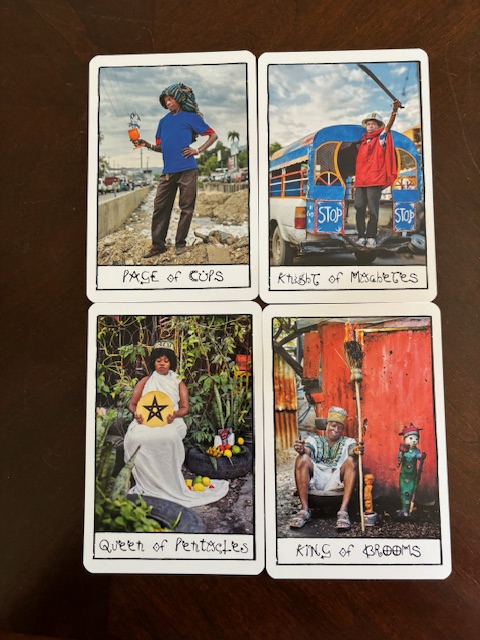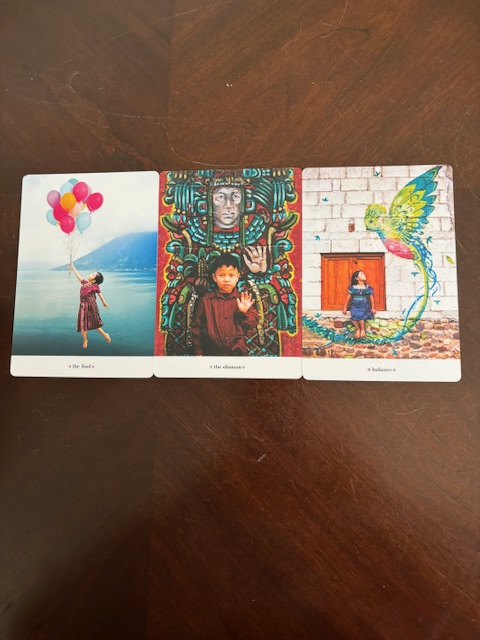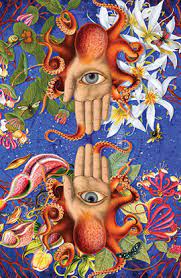Author: Caitlin Matthews
Deck: Waite-Smith Tarot
REDFeather
October 2023
ISBN #978-0764366956
“The Time Changers Tarot: Reading for Yourself, Your Community, and Your World with the Waite-Smith Yarot” is a 360-page book, accompanied by a miniature version of the Waite-Smith Tarot. The book and deck come in a solid box with a magnetic closure on the right-hand side.
The cards are 2 1/8” by 3 1/2 “and are of sturdy cardstock. The card faces have a ¼” white border and are color-intensive. The card backs are yellow and black, with a spiraling design.
The book cover shows a circular Tree of Life design, with the tree surrounded by images from the Tarot. The book is white, with a circular image in the middle. The book’s sub-title is in the middle of the circle, surrounded by images from the Tarot.
The focus of this book is to take the classic Waite-Smith deck and use it to address the needs of the 21st century. Each reader is considered to be a time changer—someone who is not only living through changing times but can also see and affect how time changes the landscape around us.
Using this book as a guide, readers can become in tune with local and world events, become environmentally responsible,
derive solutions to modern issues and show how everyone can be part of those solutions.
In her foreword, Linda Henery speaks of the Tarot bringing “hope how readers and help.” She sees this book as enabling the reader to see the world through different models, and to bring clarity to jumbled thought, and that it is all about asking the right questions.
The book begins with an explanation of why the Waite-Smith Tarot was used, and how readers can become changers. How the ripples of change begin with the self, moving on to families and ancestors, moving further on to community, group, tribe, and nation, and then on to universe, nature, environment, and spirit.
The Major Arcana is addressed as a template for spirit. Mention is made of the origin of the card backs, in that the imagery is that of one of the internal lining stones of Cairn Holy 1. Each of the Major Arcana is presented with a small color image, an explanation of the image, the focus of the card, background on the card, and sections on opportunity, change, clearing the way, and environmental, followed by a short list of questions.
The Minor Arcana are presented as four paths to understanding. Swords are the path of struggle, Wands are the path of power, Cups are the path of loving, and Pentacles are the path of provision. The Court cards are presented as the peopling cards.
The numbered cards (Ace through Ten) are presented with a small color image, an explanation of the image, the card’s focus, background information on the card, sections on lifestyle, interaction, impact and environmental information, as well as questions that can be asked of the card.
The Court cards are presented with a small color image, an explanation of the image, the card’s focus, background on the card, the person represented in the card, process, events, environmental information, and questions to ask the card.
There is a whole section on time-changing skills and strategy, including questions in binary formats, questions that use conditional tense, questions that include a third party, question about serious matters, questions with a sell-by date, questions that the cards ask you, and questions that have dynamic power to act as a can opener to a blocked or unclear situation.
There is also a discussion of how significators give context to a reading.
The primary focus of this book is reading for ourselves, our community, and our world. There is quite an interesting section on building community spreads. It starts out with the spirit/core value of the group, with the next layer being the powers of the group, and the third layer being the activities of the group. This gives a very broad perspective.
There is a list of questions to ask, then there is a spread entitled Widening the Circle. Other spreads in this chapter include Supporting The Hospital Trust, From Here To There, Under The Prevailing Conditions, Tero Goldenhill’s Hazmat Suit Spread, and Seven Ways Of Engaging With The Spirits Of Community.
There is a graphic in the chapter on reading for our world that fascinates me. The large circle in the center is entitled The Knowing Field. This circle is surrounded by smaller circles entitled Universal Zone, Family and Ancestors Zone. Community and Group Zone, and Personal Zone.
Spreads in this chapter include Working Within The Knowing Field and the Affinity Spread. There is also an interesting commentary on inviting animals into the Knowing Field.
The chapter entitled Engaging The Powers Beyond Time begins with a listing of Ambassadors and Their Powers, which is a list of the Major Arcana and the power that each one carries. There is also a thought-provoking graphic that places the querent in a circle in the middle, surrounded by circles that are entitled Ancestral Lineage, Social/National Lineage, Vocational Lineage, and Spiritual/Environmental Lineage,
At the end of the book are notes and a selected bibliography.
This is a book that needed to be written, that is well researched and well written and serves as an excellent resource for reading beyond self to community, national, and global levels. It opens the readers perspective and allows them to see themselves as living in a time of change, where they can also effect change.
For those who want to do the work, I highly recommend this book.
© December 2023 Bonnie Cehovet
Reproduction is prohibited without the author’s written permission.
This material is not to be used in any connection with AI.





































